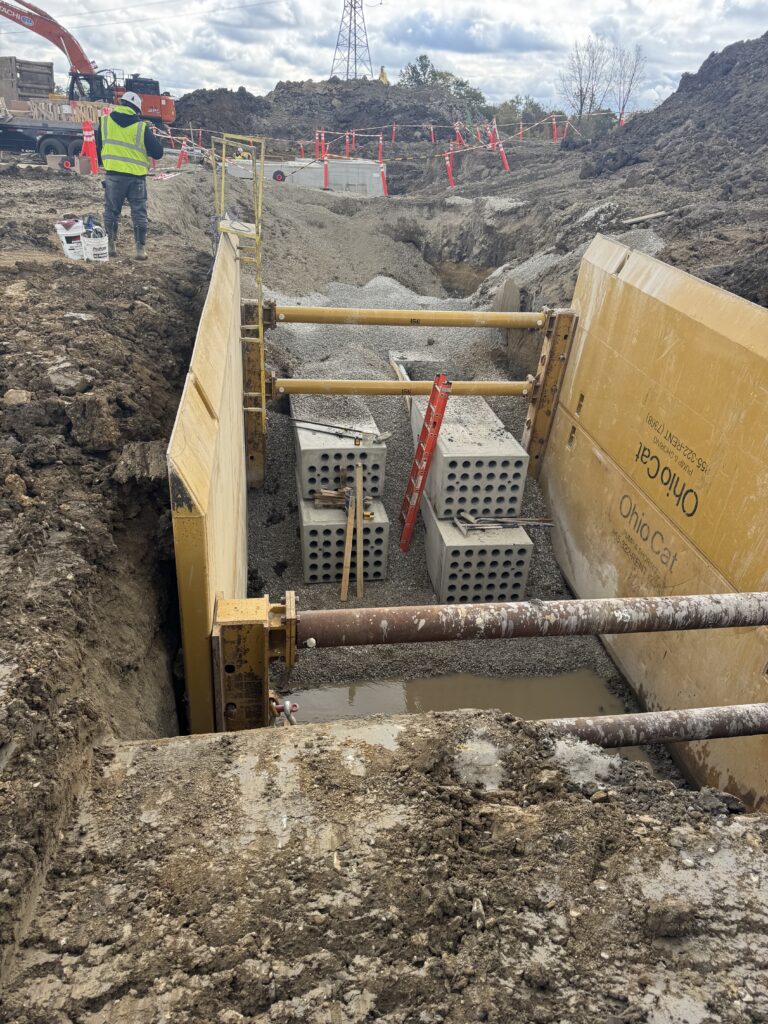We’ve worked alongside hundreds of electrical contractors and foremen in the field, and while every site is different, the same mistakes show up again and again. They’re not caused by poor crews — they’re caused by pressure, pace, and missing information at the start. Here are the top five installation issues we see most often — and how the right process, training, and support can prevent them before the trench ever opens.
1. Joint Misalignment
What happens: Crews try to set sections too tight or guide them by hand. Without mechanical alignment, conduits end up offset or twisted just enough to make cable pulls difficult — or impossible.
Why it matters: Even a ¼-inch conduit mismatch can create drag that damages insulation or forces re-pulls later.
How DBO prevents it: Our guided dowel-pin system locks each section automatically as it sets — no hands between pieces, no pry bars, no guesswork. Operators only need to land within about 18 inches of target, and the pins handle the rest. That’s why even first-time precast crews achieve perfect alignment on their first day.
2. Poor Grading or Bedding Prep
What happens: Crews rush bedding prep or skip compaction to save time. The result is rocking, gaps under conduits, or uneven bearing — problems that show up during backfill or inspection.
Why it matters: Uneven support stresses the duct bank and can crack conduits over time. Once it’s backfilled, it’s too late to fix.
How DBO prevents it: We verify trench grade and bedding before the first set during our on-site startup support. Field reps help foremen confirm compaction and depth so every section lands level and stays that way. It’s a ten-minute check that can save days of rework.
3. Missing or Improper Closure Pours
What happens: At tie-ins or transitions, crews skip the closure pour or use the wrong mix. Those weak spots become points of water intrusion or mechanical stress.
Why it matters: One bad closure pour can compromise an entire run — it’s where cracks and leaks start.
How DBO prevents it: We provide clear closure-pour details and pre-verified mix specs with every delivery package. Our field techs walk through those steps with your foreman before the first install, ensuring transitions are watertight and structurally continuous.
4. Rushing the First Section
What happens: Crews set the first piece in the trench without confirming line and grade, assuming they can “fix it” in later sections. That first mistake compounds through every following section.
Why it matters: If the first duct bank is off by an inch at the start, it’s off by a foot at the finish.
How DBO prevents it: We always start with a layout check and dry-fit before the first piece is permanently set. That 15-minute setup eliminates the most common alignment rework on precast jobs.
5. Overlooking Joint Seals
What happens: Joints are left unsealed, or seals are applied inconsistently when the crew is racing weather. Later, inspectors flag it or water finds its way in.
Why it matters: Water intrusion shortens cable life and adds long-term maintenance risk.
How DBO prevents it: Our modules include integrated gasketed joints or clear sealant instructions for the exact environmental rating required. DBO’s field support team double-checks seals during startup so you pass inspection the first time.
Avoid the Learning Curve
Every mistake above can be prevented with training and guided startup support. Our Training Facility lets your crew practice full installations in a controlled environment before they hit the field. And when you start your first project, DBO’s field experts are there to walk through the sequence step-by-step until your team’s confident and running at full speed.
The result:
- No rework.
- No surprises.
- A trench that opens and closes the same day.
If your next project includes underground duct banks, talk to us before it starts — we’ll make sure your first day in the trench sets the pace for the whole job.



